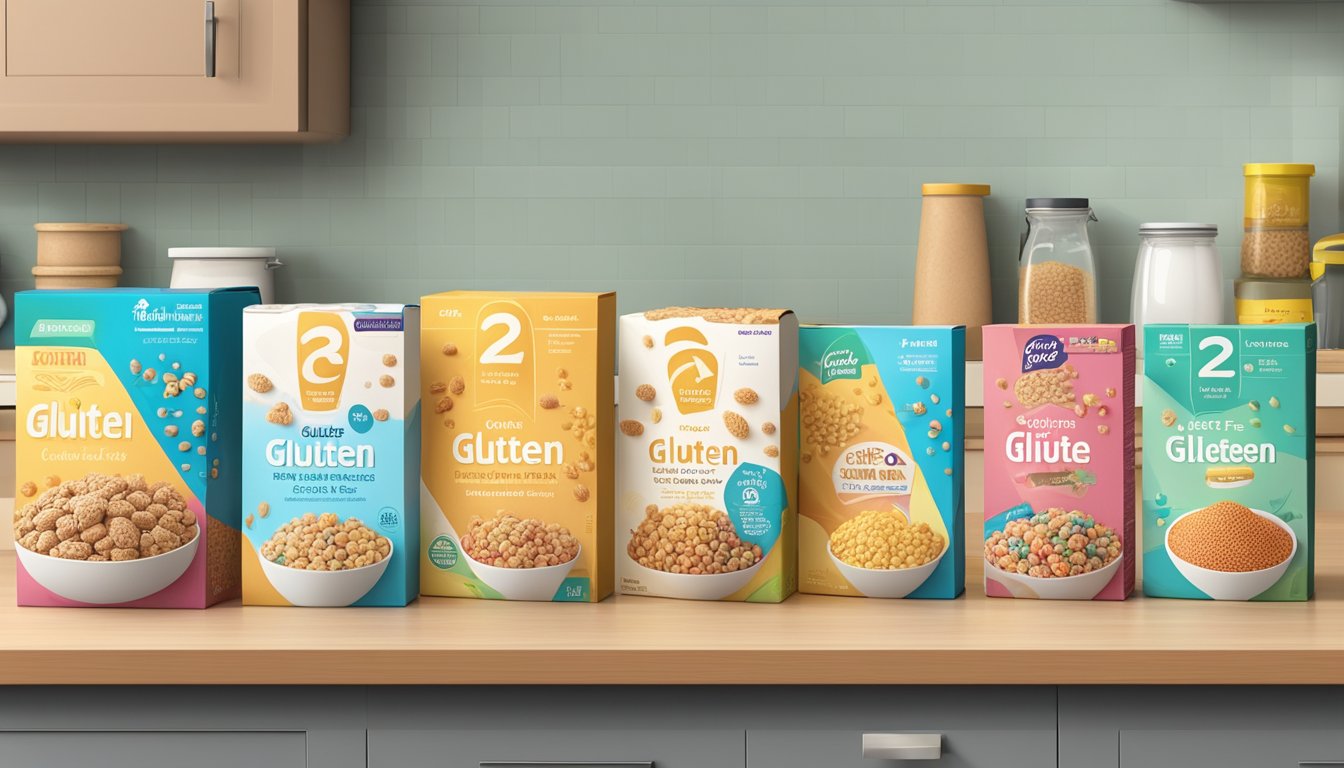Breakfast cereals are a staple in many households, providing a quick and convenient meal to start the day. For those following a gluten-free diet, finding suitable options can be challenging. Fortunately, the market now offers a wide variety of gluten-free cereals to cater to different tastes and dietary needs.
Many popular breakfast cereals, including Cheerios, Chex, and Annie’s Cinnamon Roll, are now available in gluten-free versions. These brands have adapted their recipes to exclude wheat, barley, rye, and other gluten-containing ingredients, making them safe for people with celiac disease or gluten sensitivity.
The range of gluten-free cereals extends beyond traditional options, with numerous brands offering innovative flavors and nutritious ingredients. From cinnamon-spiced varieties to fruity blends, there are choices to suit various preferences. When selecting a gluten-free cereal, it’s essential to check the label for clear gluten-free certification to ensure safety and peace of mind.
Understanding Gluten and Celiac Disease
Gluten is a protein found in wheat, barley, and rye. It gives bread and other baked goods their chewy texture and elasticity.
For most people, consuming gluten poses no issues. However, individuals with celiac disease or gluten intolerance must avoid it entirely.
Celiac disease is an autoimmune disorder affecting about 1% of the global population. When people with celiac disease eat gluten, their immune system attacks the small intestine.
This immune response damages the intestinal lining and can lead to malnutrition, digestive issues, and other health problems. The only treatment is a strict gluten-free diet.
Gluten intolerance, while not an autoimmune condition, can cause similar symptoms to celiac disease. These may include:
- Bloating
- Diarrhea
- Abdominal pain
- Fatigue
- Headaches
People with gluten intolerance often feel better when they eliminate gluten from their diet. However, they may not experience the same level of intestinal damage as those with celiac disease.
For both groups, finding gluten-free alternatives to common foods like breakfast cereals is crucial. Many manufacturers now produce certified gluten-free cereals to meet this need.
Essentials of a Gluten-Free Diet
A gluten-free diet requires careful attention to ingredients and food preparation. Understanding what makes cereals gluten-free, avoiding cross-contamination, and interpreting labeling standards are crucial for those with gluten sensitivities.
What Makes a Cereal Gluten-Free
Gluten-free cereals are made from grains that naturally lack gluten. Common options include rice, corn, quinoa, and millet. Oats are inherently gluten-free but often face cross-contamination issues during processing.
Many popular cereals now offer gluten-free versions. For example, Cheerios and Chex have gluten-free variants made from safe ingredients.
It’s essential to check labels carefully, as some cereals may contain hidden sources of gluten like malt flavoring or wheat starch.
Avoiding Cross-Contamination
Cross-contamination poses a significant risk for those on a gluten-free diet. This can occur during manufacturing, packaging, or preparation.
To minimize risks:
- Choose cereals produced in dedicated gluten-free facilities
- Use separate utensils and preparation areas for gluten-free foods
- Avoid bulk bins, as they may contain traces of gluten from other products
Manufacturers often use specialized cleaning processes and testing to ensure their gluten-free products meet safety standards.
Gluten-Free Labeling Standards
The FDA regulates gluten-free labeling in the United States. Products labeled “gluten-free” must contain less than 20 parts per million (ppm) of gluten.
Certifications from third-party organizations provide additional assurance. Look for symbols from:
- Gluten-Free Certification Organization (GFCO)
- Celiac Support Association (CSA)
- National Celiac Association (NCA)
These certifications often have stricter standards than the FDA, with some requiring less than 10 ppm of gluten.
Reading ingredient lists remains crucial, even for certified products. Manufacturers may change formulations, so regular label checks are advisable.
Popular Gluten-Free Cereal Brands
Many major cereal manufacturers now offer gluten-free options. These products cater to those with celiac disease, gluten sensitivity, or those choosing to avoid gluten in their diets. Several well-known brands have adapted their popular cereals or created new gluten-free varieties.
General Mills and Cheerios Range
General Mills has made significant strides in the gluten-free cereal market. Their Cheerios line now includes several gluten-free options. Original Cheerios, Honey Nut Cheerios, and Multi Grain Cheerios are all produced without gluten-containing ingredients.
The company uses oats that are specially processed to remove stray wheat, rye, or barley. This allows them to meet the FDA’s gluten-free standards of less than 20 parts per million of gluten.
Lucky Charms, another General Mills favorite, is also gluten-free. The cereal maintains its signature marshmallows and taste while being safe for those avoiding gluten.
Kellogg’s and Nature’s Path Selections
Kellogg’s offers several gluten-free cereals. Their Rice Krispies Gluten Free cereal is made with brown rice instead of barley malt. This alteration allows those on gluten-free diets to enjoy the classic crispy rice cereal.
Nature’s Path, known for organic products, provides a wide range of gluten-free options. Their cereals include Fruit & Nut Granola, Crunchy Maple Sunrise, and Gorilla Munch.
These products are certified gluten-free and use ingredients like corn, rice, and quinoa. Nature’s Path ensures their gluten-free items contain less than 20 parts per million of gluten.
Other Notable Brands and Products
Barbara’s offers gluten-free corn flakes, providing a classic cereal option without gluten. Their product is made with non-GMO corn and is certified gluten-free.
Catalina Crunch produces low-carb, gluten-free cereals in various flavors. These cereals use plant protein and fiber to create a crunchy texture without grains.
Annie’s, owned by General Mills, offers a gluten-free Cinnamon Roll cereal. This product combines the flavor of a cinnamon roll with the convenience of breakfast cereal.
These brands demonstrate the growing variety of gluten-free cereals available. Consumers now have options ranging from traditional flavors to innovative new products.
Comprehensive Gluten-Free Cereal List
Many popular cereals contain gluten, but numerous gluten-free options exist for those with celiac disease or gluten sensitivity. Here’s a list of gluten-free cereals to consider:
- Magic Spoon (all flavors)
- Annie’s Cinnamon Roll Cereal
- Chex (Rice, Corn, Honey Nut, Cinnamon, Chocolate)
- Nature’s Path (various flavors)
- Cheerios (original and most flavors)
Oatmeal enthusiasts can enjoy gluten-free options from brands like Bob’s Red Mill and Quaker. These companies use dedicated gluten-free oats to prevent cross-contamination.
Gluten-free muesli and granola are available from brands such as Seven Sundays and Purely Elizabeth. These products often incorporate nuts, seeds, and dried fruits for added flavor and nutrition.
For a unique breakfast experience, Ancient Harvest Quinoa Flakes offer a gluten-free alternative to traditional hot cereals. Maple buckwheat flakes provide another tasty option for those avoiding gluten.
When selecting gluten-free cereals, it’s crucial to check labels carefully. Some products may contain trace amounts of gluten due to shared manufacturing facilities.
Note: This list is not exhaustive, and product formulations can change. Always verify gluten-free status before consuming.
Gluten-Free Cereal Ingredients and Nutrition

Gluten-free cereals utilize alternative grains and ingredients to create nutritious breakfast options. These products cater to those with celiac disease, gluten sensitivity, or dietary preferences.
Gluten-Free Grains and Alternatives
Common gluten-free grains used in cereals include rice, corn, quinoa, and millet. Many brands incorporate crispy rice cereal as a base. Gluten-free oats are also popular, but must be certified to avoid cross-contamination.
Chex cereals offer several gluten-free varieties made with rice or corn. Cocoa Pebbles and Fruity Pebbles are gluten-free options made from rice.
Some cereals use alternative ingredients like nuts, seeds, or legumes to enhance flavor and nutrition. Amaranth, buckwheat, and sorghum are less common but nutritious gluten-free grains found in specialty cereals.
Nutritional Considerations for Gluten-Free Cereals
Gluten-free cereals can be part of a balanced diet when chosen carefully. Many are fortified with vitamins and minerals to match their wheat-based counterparts.
Whole grain gluten-free cereals provide fiber, which is important for digestive health. Look for products that list whole grains as the first ingredient.
Some gluten-free cereals may be higher in sugar or lower in protein than traditional options. Check nutrition labels to compare fiber, protein, and sugar content.
Fortified gluten-free cereals can help meet daily requirements for B vitamins, iron, and folic acid. These nutrients are often found in wheat-based products.
Safe Preparation and Consumption
Preparing and consuming gluten-free cereals requires careful attention to avoid cross-contamination. Always check labels to ensure products are certified gluten-free.
Store gluten-free cereals separately from gluten-containing items. Use dedicated utensils and containers for serving and storage to prevent accidental gluten exposure.
Clean countertops, toasters, and other kitchen surfaces thoroughly before preparing gluten-free cereals. Consider using a separate toaster for gluten-free items.
When dining out or at friends’ homes, communicate dietary needs clearly. Bring your own cereal if uncertain about available options.
The Nima sensor can detect gluten in foods, providing an extra layer of assurance for those with celiac disease or gluten sensitivity. However, it should not replace careful label reading and safe preparation practices.
Choose gluten-free breakfast options from reputable brands that regularly test their products. Look for cereals made with naturally gluten-free grains like rice, corn, or quinoa.
Be cautious of cereals containing oats. While oats are naturally gluten-free, they are often cross-contaminated during processing. Select oat-based cereals specifically labeled as gluten-free.
Special Diets and Gluten-Free Cereals
Gluten-free cereals cater to various dietary needs beyond celiac disease. Many brands offer options compatible with paleo, low-carb, and soy-free diets.
Paleo and Low-Carb Alternatives
Paleo-friendly cereals exclude grains and focus on nuts, seeds, and dried fruits. Popular brands like Paleonola and Wildway offer grain-free granola options. These cereals often use coconut, almonds, and pumpkin seeds as base ingredients.
Low-carb gluten-free cereals are gaining popularity. Catalina Crunch and Magic Spoon produce protein-rich, low-sugar options. These brands use alternative sweeteners like stevia or monk fruit to reduce carbohydrate content.
Some paleo and low-carb cereals incorporate superfood ingredients:
- Chia seeds
- Hemp hearts
- Flaxseed
These additions boost nutritional value without adding gluten or excess carbs.
Soy-Free and Other Dietary Requirements
Many gluten-free cereals are also soy-free, catering to those with soy allergies or sensitivities. Brands like Nature’s Path and Erewhon offer soy-free, gluten-free options.
Some gluten-free cereals address multiple dietary restrictions:
- Dairy-free
- Egg-free
- Nut-free
These cereals often use alternative grains like quinoa, amaranth, or teff. Barbara’s Puffins and Envirokidz cereals are examples of brands meeting multiple dietary needs.
For those following kosher or halal diets, many gluten-free cereals carry appropriate certifications. Always check labels for specific dietary compliance.
Where to Buy and How to Choose Gluten-Free Cereals
Gluten-free cereals are widely available in grocery stores, health food shops, and online retailers. Many major supermarkets now stock dedicated gluten-free sections.
When selecting gluten-free cereals, always check the packaging for clear “gluten-free” labeling. Look for trusted brands like Bob’s Red Mill, Arrowhead Mills, and Cascadian Farms.
Avoid cereals containing wheat, barley, rye, or oats unless specifically labeled gluten-free. Common gluten-free options include:
- Rice-based cereals (e.g. Rice Krispies Gluten Free)
- Corn-based cereals (e.g. Corn Flakes Gluten Free)
- Quinoa cereals
- Buckwheat cereals
Some popular gluten-free breakfast cereals include Honey Rice Puffins, Cream of Rice, and certain varieties of Cheerios. Newer brands like Lovebird also offer innovative gluten-free options.
Be cautious with oat-based cereals, as oats can be cross-contaminated. Choose only those specifically labeled gluten-free.
Read ingredient lists carefully. Some cereals may contain hidden sources of gluten in flavorings or additives.
Consider nutritional value when choosing. Opt for cereals with higher fiber and protein content, and lower added sugars.
For the freshest options, purchase from stores with high turnover. Always check expiration dates and store cereals in airtight containers to maintain freshness.




